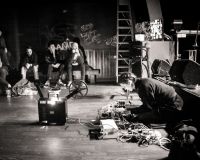Lunchtime talk write-up
Posted on Tue 23 Jun 2015
Nano Simbox
At the beginning of March, we were joined by residents Becky Sage and Mike O’Connor, who discussed iSci’s latest interactive simulation of the molecular nano-world; Nano Simbox. Developed out of its precursor project, the hugely successful touring installation, danceroom Spectroscopy, Nano…
Posted by

Jasmine Butt
Jasmine is a musician, synth builder and AV artist who is currently exploring modular synthesis.Speaker

Becky Sage
Becky Sage is a creative producer, driving projects that combine science and art to observe and discover the world around us.At the beginning of March, we were joined by residents Becky Sage and Mike O’Connor, who discussed iSci’s latest interactive simulation of the molecular nano-world; Nano Simbox. Developed out of its precursor project, the hugely successful touring installation, danceroom Spectroscopy, Nano Simbox is a table-top experience, which was initially developed as a learning tool in Key Stage 3 Science and is now being adapted for different age groups. Becky and Mike told us about the project, how it evolved and what they plan to do next.
danceroom Spectroscopy – iSci are well known for their large scale installations, which seek to engage people with the hidden world of quantum physics. The idea of danceroom Spectroscopy first came from Dr David Glowacki, who wanted to take scientific visualisation out of textbooks and into playful, multisensory spaces. He joined forces with a team of artists and technologists to create an experience that would engage people with the concept of quantum physics, and illustrate the dynamism of the nano world. danceroom Spectroscopy makes use of Kinect Sensors to allow people’s movements to manipulate visuals and sound. As the audience move, projected visualisations of their energetic fields appear among a beautiful simulation of travelling atoms. The atoms, usually represented by orbs of coloured light, interact with people’s fields. As people play with the simulation, they are also playing with the sound around them, as the dynamics of the simulation are transformed in real-time into a rich, layered soundscape. As well as developing Hidden Fields, a dance performance choreographed around the installation, the team invited schools to play with the system. When they saw how engaged the classes became as soon as their own avatars were projected in front of them, they realised the impact that this kind of interaction could have in early stages of education.
Nano Simbox - Having developed danceroom Spectroscopy, iSci have built up a considerable amount of expertise around interaction design and science visualisation. Now used to working with supercomputers, the team’s next challenge lay in creating an inexpensive, portable experience for classrooms. Using Leap Motion Sensors, Nano Simbox can recognise the movement of a hand as it hovers above a laptop or desktop computer, and visualise it interacting with a soup of molecules on-screen, in real time. Students will be able to use different gestures to navigate the 3D space and grab molecules. They will also be able to use hand gestures to change variables such as type of molecule, temperature, volume and pressure. The behaviour of the molecules will change according to the simulation’s settings. They are also developing the software for touch screen, mouse and keyboard. Here’s a video of Nano Simbox being used with the leap motion sensor:
Nano Simbox from Yoho Media on Vimeo.
Dispelling science myths - Becky spoke to us about iSci’s mission to dispel some of the myths that linger around the sciences. The Nano Simbox team not only want to engage students with the fundamental behaviour of atoms and molecules, but with the notion that the ways in which we visualise the nano world is artistic representation. We cannot see atoms and molecules and although scientific experiment gives us an idea, we don’t actually know what they look like. iSci want to fuse art with science to give young people a better sense that scientific enquiry can be playful, and not totally objective. At a research level, science is about creating models of the world around us, and the process of developing theories from scientific evidence can be a creative process. We all create our own mental models in order to understand, and iSci want to inspire peoples imaginations by showing scientific representation that departs from the images of rigid ball and stick structures that a lot of us are used to.
Over the next few months, iSci will be trialling Nano Simbox with over 1000 students and teachers in local schools. Follow @nanosimbox to keep up to date with the project's progression.